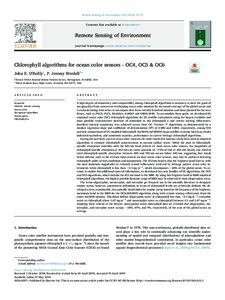| dc.contributor.author | O'Reilly, John E. | |
| dc.contributor.author | Werdell, P. Jeremy | |
| dc.date.accessioned | 2021-01-04T22:02:41Z | |
| dc.date.available | 2021-01-04T22:02:41Z | |
| dc.date.issued | 2019 | |
| dc.identifier.citation | O'Reilly, J.E. and Werdell, P.J. (2019) Chlorophyll algorithms for ocean color sensors - OC4, OC5 & OC6. Remote Sensing of Environment, 229, pp.32-47. DOI: https://doi.org/10.1016/j.rse.2019.04.021. | en_US |
| dc.identifier.uri | http://hdl.handle.net/11329/1476 | |
| dc.identifier.uri | http://dx.doi.org/10.25607/OBP-978 | |
| dc.description.abstract | A high degree of consistency and comparability among chlorophyll algorithms is necessary to meet the goals of
merging data from concurrent overlapping ocean color missions for increased coverage of the global ocean and
to extend existing time series to encompass data from recently launched missions and those planned for the near
future, such as PACE, OLCI, HawkEye, EnMAP and SABIA-MAR. To accomplish these goals, we developed 65
empirical ocean color (OC) chlorophyll algorithms for 25 satellite instruments using the largest available and
most globally representative database of coincident in situ chlorophyll a and remote sensing reflectances.
Excellent internal consistency was achieved across these OC ‘Version -7’ algorithms, as demonstrated by a
median regression slope and coefficient of determination (R2) of 0.985 and 0.859, respectively, among 903
pairwise comparisons of OC-modeled chlorophyll. SeaWiFS and MODIS-Aqua satellite-to-in situ match-up results
indicated equivalent, and sometimes superior, performance to current heritage chlorophyll algorithms.
During the past forty years of ocean color research the violet band (412 nm) has rarely been used in empirical
algorithms to estimate chlorophyll concentrations in oceanic surface water. While the peak in chlorophyllspecific
absorption coincides with the 443 nm band present on most ocean color sensors, the magnitude of
chlorophyll-specific absorption at 412 nm can reach upwards of ~70% of that at 443 nm. Nearly one third of
total chlorophyll-specific absorption between 400 and 700 nm occurs below 443 nm, suggesting that bands
below 443 nm, such as the 412 nm band present on most ocean color sensors, may also be useful in detecting
chlorophyll under certain conditions and assumptions. The 412 nm band is also the brightest band (that is, with
the most dominant magnitude) in remotely sensed reflectances retrieved by heritage passive ocean color instruments
when chlorophyll is less than ~0.1 mgm−3, which encompasses ~24% of the global ocean. To attempt
to exploit this additional spectral information, we developed two new families of OC algorithms, the OC5
and OC6 algorithms, which include the 412 nm band in the MBR. By using this brightest band in MBR empirical
chlorophyll algorithms, the highest possible dynamic range of MBR may be achieved in these oligotrophic areas.
The terms oligotrophic, mesotrophic, and eutrophic get frequent use in the scientific literature to designate
trophic status; however, quantitative definitions in terms of chlorophyll levels are arbitrarily defined. We developed
a new, reproducible, bio-optically based index for trophic status based on the frequency of the brightest,
maximum band in the MBR for the OC6_SEAWIFS algorithm, along with remote sensing reflectances from the
entire SeaWiFS mission. This index defines oligotrophic water as chlorophyll less than ~0.1 mgm−3, eutrophic
water as chlorophyll above 1.67 mgm−3 and mesotrophic water as chlorophyll between 0.1 and 1.67 mgm−3.
Applying these criteria to the 40-year mean global ocean chlorophyll data set revealed that oligotrophic, mesotrophic,
and eutrophic water occupy ~24%, 67%, and 9%, respectively, of the area of the global ocean on
average. | en_US |
| dc.language.iso | en | en_US |
| dc.rights | Attribution-NonCommercial-NoDerivatives 4.0 International | * |
| dc.rights.uri | http://creativecommons.org/licenses/by-nc-nd/4.0/ | * |
| dc.subject.other | Satellite remote sensing | en_US |
| dc.subject.other | Ocean colour | en_US |
| dc.subject.other | Bio-optical algorithms | en_US |
| dc.subject.other | Ocean optics | en_US |
| dc.subject.other | Chlorophyll-a | en_US |
| dc.title | Chlorophyll algorithms for ocean color sensors - OC4, OC5 & OC6. | en_US |
| dc.type | Journal Contribution | en_US |
| dc.description.refereed | Refereed | en_US |
| dc.format.pagerange | pp.32-47 | en_US |
| dc.identifier.doi | https://doi.org/10.1016/j.rse.2019.04.021 | |
| dc.subject.parameterDiscipline | Parameter Discipline::Chemical oceanography::Other organic chemical measurements | en_US |
| dc.bibliographicCitation.title | Remote Sensing of Environment | en_US |
| dc.bibliographicCitation.volume | 229 | en_US |
| dc.description.sdg | 14.A | en_US |
| dc.description.eov | Ocean colour | en_US |
| dc.description.maturitylevel | TRL 8 Actual system completed and "mission qualified" through test and demonstration in an operational environment (ground or space) | en_US |
| dc.description.bptype | Manual (incl. handbook, guide, cookbook etc) | en_US |
| obps.contact.contactname | P.J. Werdell | |
| obps.contact.contactemail | jeremy.werdell@nasa.gov | |
| obps.resourceurl.publisher | https://www.sciencedirect.com/science/article/pii/S003442571930166X | en_US |
 Repository of community practices in Ocean Research, Applications and Data/Information Management
Repository of community practices in Ocean Research, Applications and Data/Information Management

